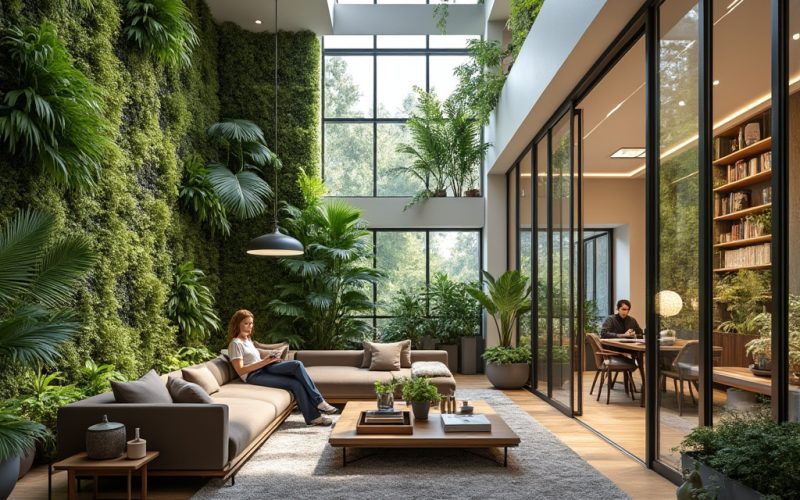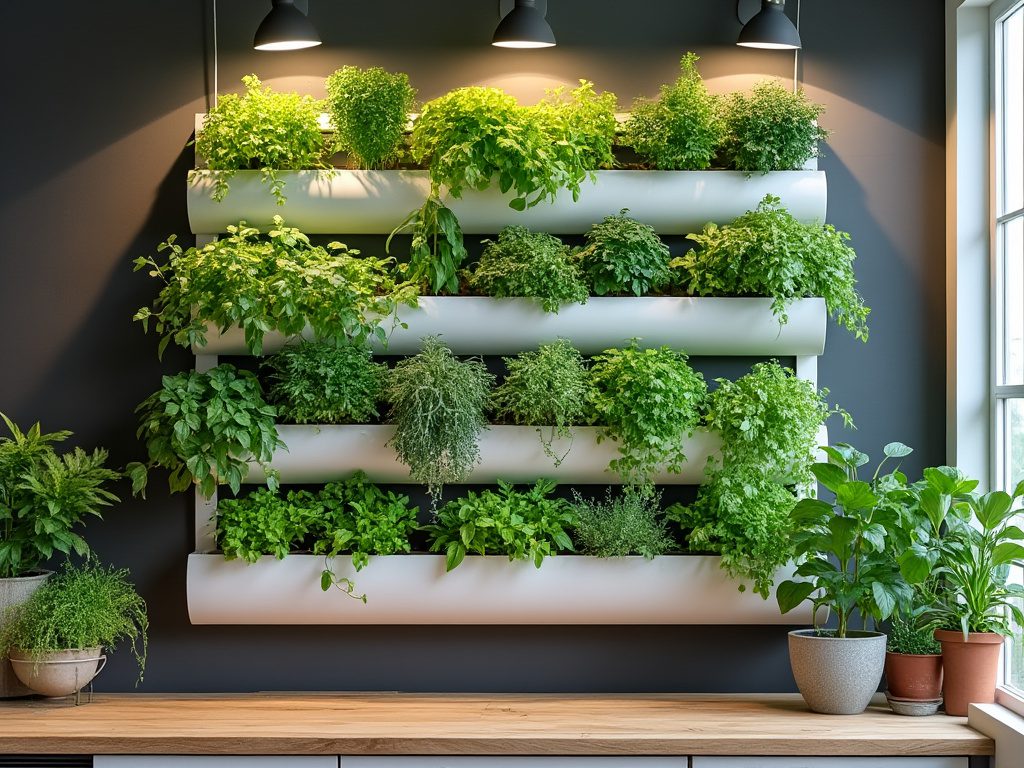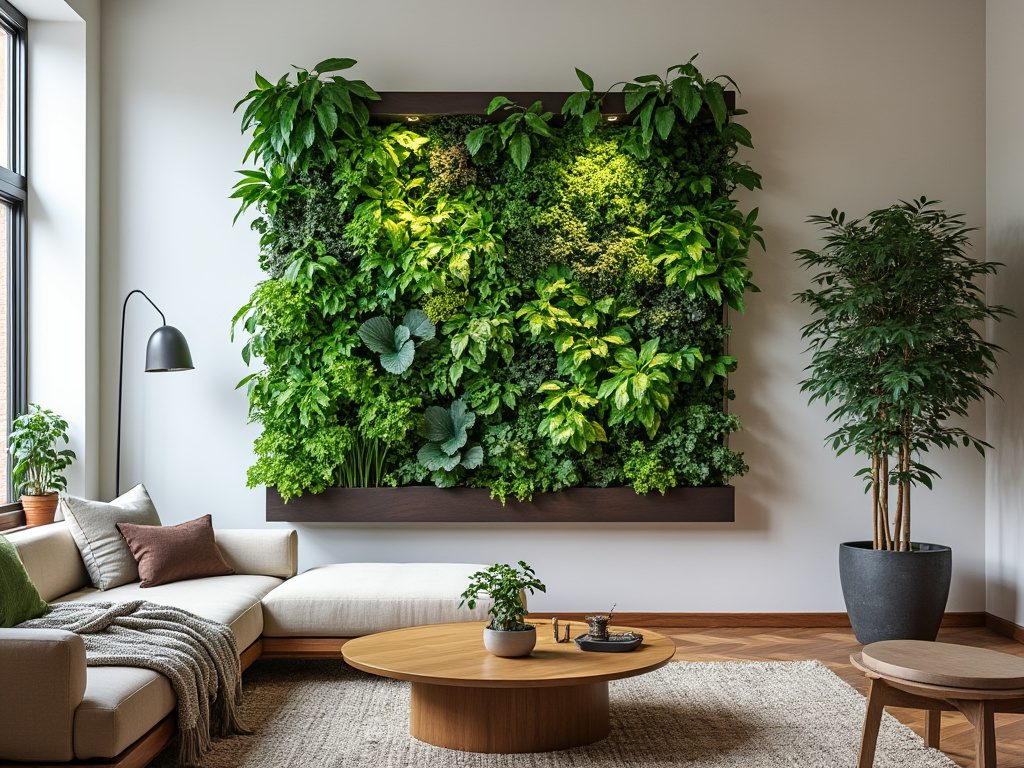
In the past we already wrote about (outside) vertical gardens, today we focus on how to create an indoor vertical garden and why you should do so. An indoor vertical garden provides a sophisticated and health-conscious way to reintroduce greenery into our daily lives. These installations don’t just beautify a space; they offer a range of scientifically supported benefits for mental and physical well-being.
Whether you’re aiming to create a more tranquil home environment or improve office productivity, vertical gardens seamlessly combine the calming influence of nature with the practicality of modern design.
Benefits of Indoor Vertical Gardens
1. Air Purification and Humidity Regulation
Indoor air quality is a growing concern, especially with studies showing that indoor air can be up to five times more polluted than outdoor air, according to the U.S. Environmental Protection Agency (EPA). Indoor vertical gardens help mitigate this issue by acting as natural air purifiers. Plants absorb harmful toxins such as formaldehyde, benzene, and volatile organic compounds (VOCs), which are commonly emitted by building materials, paint, and household cleaners.
For example, research from NASA’s Clean Air Study highlights specific plants that excel at filtering indoor air. Spider plants (Chlorophytum comosum), for instance, can remove up to 95% of formaldehyde from the air, while peace lilies (Spathiphyllum) are known to filter benzene and VOCs.
Plants also play a vital role in humidity regulation. Through transpiration, plants release water vapor into the air, which increases indoor humidity levels and prevents overly dry air that can exacerbate respiratory issues and skin irritation. Ferns (Nephrolepis exaltata) and Boston ferns, in particular, are highly effective at regulating moisture levels, making them ideal choices for maintaining a balanced indoor climate.
2. Mental Health Benefits
Research consistently shows that exposure to plants improves mental health, and indoor vertical gardens can replicate the soothing effects of nature indoors. Studies, including one from the Journal of Environmental Psychology, have demonstrated that having plants in a room can reduce stress levels, improve concentration, and foster a more positive mood.
For example, a study published in the Journal of Physiological Anthropology found that participants who spent time with plants, even through minimal interaction, experienced lowered blood pressure and reduced cortisol levels. This is particularly valuable in high-stress environments such as workplaces or urban apartments where access to nature may be limited.
Plants such as lavender (Lavandula angustifolia) and jasmine (Jasminum officinale) are excellent choices for vertical gardens aimed at improving mental wellness, as their scents are known to promote relaxation and reduce anxiety.
3. Space-Saving Design for Compact Living Areas

In cities where real estate comes at a premium, the space-saving design of vertical gardens makes them an attractive option. Studies show that urban populations are increasingly moving toward smaller living spaces, with the average size of new apartments in cities like New York and London shrinking over the past decade. Vertical gardens provide a way to enjoy the benefits of greenery without taking up valuable floor space.
For example, a study conducted by the University of Georgia found that plants in urban environments contributed to feelings of well-being and reduced stress for city dwellers. Vertical gardens allow city residents to cultivate plants like herbs, succulents, or flowering vines on walls, maximizing the use of compact living spaces. Wall-mounted herb gardens are a popular option, as they can provide easy access to fresh basil, mint, or rosemary without cluttering countertops.
4. Easy Maintenance with Modern Solutions
Technology has revolutionized plant care, making it easier than ever to maintain a thriving indoor vertical garden. Automated irrigation systems, for example, ensure that plants receive consistent watering without human intervention, reducing the risk of overwatering or underwatering. A study published in the journal HortTechnology found that hydroponic systems, which use nutrient-rich water instead of soil, require 20-50% less water compared to traditional gardening methods.
Hydroponic vertical gardens also reduce the chances of pest infestations and soil-borne diseases. Popular low-maintenance plants like succulents (Echeveria spp.) and air plants (Tillandsia spp.) thrive in hydroponic systems and require little attention, making them perfect for busy urbanites or beginners.
5. Enhancing Indoor Aesthetics and Interior Design

Beyond their health benefits, vertical gardens serve as living pieces of art, bringing color, texture, and movement into a room. According to a study in the Journal of Sustainable Cities and Society, green spaces, including indoor plants, improve cognitive function and creativity. A well-designed vertical garden can function as a focal point in a room, transforming a bland wall into a lush, visually engaging feature.
Different plant species can create various design effects. For example, plants like English ivy (Hedera helix) and creeping fig (Ficus pumila) can be trained to grow vertically, offering an elegant, trailing aesthetic. Meanwhile, flowering plants like begonias (Begonia spp.) or orchids (Orchidaceae) can add pops of color and visual interest to the installation.
For a sleek, modern look, consider integrating plants with contrasting textures and colors, such as the smooth, fleshy leaves of jade plants (Crassula ovata) alongside the delicate, feathery fronds of ferns. These combinations add depth and dimension to the design, enhancing the overall interior aesthetic.
6. Creating a Healthier Work Environment

Incorporating indoor vertical gardens in workspaces is a proven way to boost employee productivity and satisfaction. A study published in the Journal of Experimental Psychology found that employees working in environments with plants reported a 15% increase in productivity, while also experiencing improved job satisfaction and reduced stress levels.
Moreover, vertical gardens can act as natural sound barriers. Plants absorb sound through their leaves and stems, reducing background noise in open office environments. A study from the Journal of Acoustics confirmed that plant installations help to diffuse sound waves, creating a quieter, more peaceful workplace. This makes vertical gardens especially valuable in busy, high-traffic areas like lobbies or coworking spaces.
Steps to Build Your Own Indoor Vertical Garden
Building an indoor vertical garden may seem complex at first, but with the right planning and materials, you can create a beautiful, low-maintenance green space. Here’s a step-by-step guide to get you started:
1. Choose the Right Location
Select a spot where your plants will get the appropriate amount of light. Many indoor plants thrive in indirect sunlight, but if your chosen area doesn’t get much light, consider installing grow lights. Assess the available wall space, ensuring it can support the weight of the plants and structure.
2. Select Your Frame or Structure
You can purchase ready-made vertical garden kits or build your own. Options include:
- Modular systems: Pre-built structures with individual pockets or shelves.
- Trellises: Ideal for vining plants that can climb.
- Hanging planters: Great for suspending plants from the ceiling or along a wall.
- Wood pallets: DIY-friendly, these can be mounted on a wall for a rustic look.
- Hydroponic setups: If you want a soil-free solution, consider hydroponic systems that use water-based nutrient delivery.
3. Install a Waterproof Backing
To prevent water damage to your walls, install a waterproof backing or liner behind your garden. Materials like PVC or plastic sheeting can serve as a barrier between the plants and the wall.
4. Choose the Right Plants
Select plants based on your indoor environment, lighting conditions, and maintenance preferences. Consider these plant categories:
- Low-light plants: Snake plants, pothos, philodendron.
- Air-purifying plants: Spider plants, peace lilies, English ivy.
- Herbs: Basil, mint, rosemary for a functional garden.
- Succulents: Aloe vera, jade plants for low-maintenance options.
5. Add a Growing Medium
Choose between soil-based or hydroponic systems:
- Soil: Use lightweight potting soil. This works well in pots or hanging pockets.
- Hydroponic: Opt for a hydroponic medium like coco coir, rockwool, or clay pebbles, which provide the necessary support and nutrients without soil.
6. Set Up Irrigation
Install an irrigation system to ensure that your plants are watered consistently:
- Drip irrigation: Automates watering by slowly delivering water to the base of each plant.
- Self-watering planters: These have a reservoir at the bottom that allows the plants to absorb water as needed.
- Manual watering: For small vertical gardens, you can manually water them, but be mindful of overwatering.
7. Mount Your Garden
Securely attach your structure to the wall using screws, brackets, or hooks. Ensure that the wall can support the weight of the garden, especially once the plants are added.
8. Plant and Arrange
Carefully plant your chosen plants in the pockets, shelves, or containers of your vertical garden. Arrange them based on light and water needs, with more light-sensitive plants at the top and shade-tolerant plants at the bottom.
9. Maintain Your Vertical Garden
Monitor the health of your plants by checking for pests, ensuring proper light exposure, and maintaining appropriate moisture levels. Prune and trim plants as needed to encourage growth and keep the garden tidy.
What Plants Should You Use for an Indoor Vertical Garden?
By selecting the right combination of these plants, you can create a visually striking and functional indoor vertical garden that enhances air quality, aesthetics, and well-being.
Here is a list of plants that are particularly suitable for indoor vertical gardens. These plants are chosen based on their adaptability to vertical spaces, low maintenance needs, air-purifying properties, and aesthetic appeal.
1. Air-Purifying Plants
These plants help clean indoor air by removing toxins like formaldehyde, benzene, and VOCs:
- Spider Plant (Chlorophytum comosum): Known for its air-purifying abilities and easy maintenance.
- Peace Lily (Spathiphyllum): Excellent at filtering VOCs and requires low light.
- English Ivy (Hedera helix): Effective in removing toxins and adds a trailing aesthetic.
- Snake Plant (Sansevieria trifasciata): Known for filtering formaldehyde and can thrive in low light.
2. Low-Maintenance Plants
These are perfect for individuals looking for plants that don’t require much attention:
- Succulents (Echeveria, Crassula spp.): Thrive with minimal water and care.
- Air Plants (Tillandsia spp.): Don’t require soil and absorb moisture and nutrients through their leaves.
- Pothos (Epipremnum aureum): A hardy plant that grows well in low light and needs little care.
- ZZ Plant (Zamioculcas zamiifolia): Known for tolerating neglect, low light, and infrequent watering.
3. Tropical Plants
These plants thrive in humid environments, making them ideal for vertical gardens that regulate indoor humidity:
- Ferns (Nephrolepis exaltata, Asplenium nidus): Excellent for humidity control, especially in bathrooms.
- Philodendron (Philodendron scandens): A vining plant that thrives in moderate light and high humidity.
- Monstera (Monstera deliciosa): Adds a bold, exotic look with its large, split leaves.
4. Herbs
Great for vertical gardens in kitchens, offering both aesthetic and functional benefits:
- Basil (Ocimum basilicum): A fragrant herb that needs good sunlight and regular watering.
- Mint (Mentha spp.): Fast-growing and low-maintenance, perfect for indoor environments.
- Rosemary (Salvia rosmarinus): Needs good light and minimal watering.
- Thyme (Thymus vulgaris): Hardy and thrives with minimal care.
5. Flowering Plants
For those who want to add color to their indoor space:
- Begonias (Begonia spp.): Bright flowers that can thrive in moderate light and add a splash of color.
- Orchids (Orchidaceae): Known for their exotic flowers, they require a bit more care but are ideal for vertical gardens.
- Geraniums (Pelargonium spp.): Low-maintenance flowering plants that can brighten up any space.
6. Trailing/Vining Plants
These plants are ideal for creating a cascading effect in vertical gardens:
- Creeping Fig (Ficus pumila): A vining plant that covers walls and provides a dense green appearance.
- Heartleaf Philodendron (Philodendron hederaceum): Known for its trailing vines and heart-shaped leaves.
- String of Pearls (Senecio rowleyanus): A unique, trailing succulent that looks stunning in vertical arrangements.
Embrace the Future of Indoor Greenery
Indoor vertical gardens are more than a design statement; they are scientifically proven to improve air quality, boost mental health, and create a healthier, more productive environment. By strategically choosing the right plants, such as air-purifying spider plants or stress-reducing lavender, you can transform any interior into a natural sanctuary. With modern irrigation systems and space-saving designs, these installations are accessible to anyone, regardless of the size of their home or the time they have for maintenance. Embrace this innovative approach to indoor greenery, and let your walls come alive with the beauty and benefits of nature.
